
|   |

|   |
Season snippets Text & pics: Lalitha Venkat, Chennai e-mail: lalvenkat@yahoo.com January 11, 2012 To watch Ramayana on New Year day seemed a good idea. As we entered German Hall, we were able to hear the last few minutes of Neyveli Santhanagopalan’s kutcheri presented by Indian Fine Arts Society. After his performance, the maestro moved to the audience to enjoy watching Anitha Guha’s dance drama Parishvanga Pattabhishekam for which he has not only composed the music but even written the lyrics. In her trademark charming manner, Revathy Sankkaran introduced the program giving an outline of Kishkinda Kandam and Sundara Kandam to be portrayed. Cleveland Sundaram presented the various Kandams of Ramayana at Cleveland with local artistes and choreographing the Kishkinda Kandam and Sundara Kandam was entrusted to the capable expertise of Anitha Guha, who put together this neatly edited 2 hour version in India for the season with her well trained dancers and guest artistes. The melodious music was composed in catchy tunes and sung by Sriranjini Santhanagopalan, Nisha Rajagopal, Gayatri Venkataraghavan and the maestro himself. The lyrics being in Tamil were easy to understand and appreciate. With a full house, Anitha Guha proved yet again that she is the queen of dance dramas in Chennai. 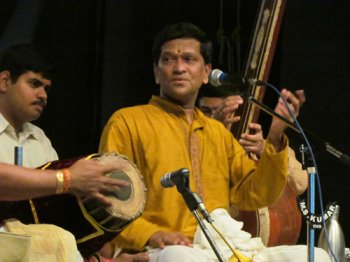 Neyveli Santhanagopalan 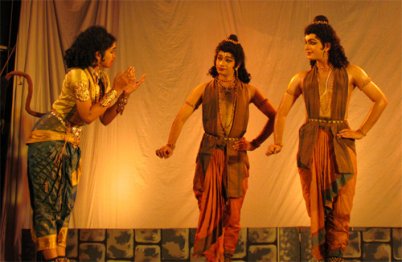 Hanuman, Lakshmana, Rama 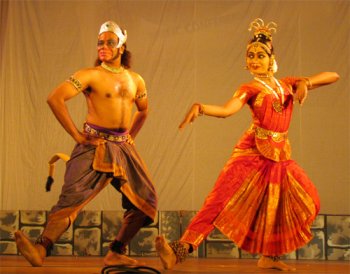 Vali & Tara 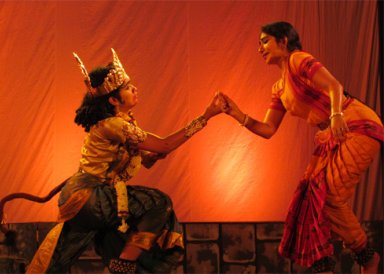 Hanuman & Sita Some of the highlights were Pavitra Bhat (as Lakshmana) emoting Rama’s story leading to Sita’s abduction to Hanuman (Sathvikaa Shankar), the arrogant stances of Vali, fight sequence between Vali (Thiruchelvam) and Sugriva (KB Madhusudanan) wonderfully choreographed by Thiruchelvam, and Vali’s lament in throes of death after being struck by Rama’s arrow, superb drama. Lankini collapsing with eyes rolling went down well with the audience. When Sita sits cowering in fear in the Ashoka vanam, her hands and fingers were actually trembling – attention to detail! The movements of Jatayu’s brother Sambadi as a bird with clipped wings was imaginatively put forth. The monkeys celebrate Hanuman (there was a tiny bell at the end of the tail!) setting Lanka on fire with a monkey thillana. One should have been totally immersed in the grand spectacle of the presentation but the venue was not conducive to that, making one wonder if dancers should be choosy about that too as part of dance aesthetics. The tattered main curtain has seen many seasons and it is high time that is replaced. Revathy Sankkaran could not locate the opening to get back into the stage after her announcement! For a dance drama performance with a large cast, the stage at German Hall was far from suitable. On the sides we could see clumps of white ropes knotted and cascading in bunches, while the white backdrop did not stretch across properly and became transparent once lights were off, so between scenes we could see all the people behind it, plus some props! Also, the poor dancers had to squeeze their way behind the white curtain whenever they had to switch entry points in view of the audience though they tried to do so as unobtrusively as possible, hiding behind the slim side wings. Hats off to them, they tried to make the best of the worst. I happened to watch this dance drama again at the beautiful Music Academy stage and that made all the difference. Once again, the dancers who played Hanuman and Vali were favorites with the audience and it was a common feeling that make-up for Rama (Yatin Agarwal) and Lakshmana (Pavitra Bhat) could have been toned down as it made them look pasty and artificial. Arangham Trust in collaboration with Brahma Gana Sabha presented ‘Saumanasa’ choreographed and performed by Chitra Chandrasekhar Dasarathy at Sivagami Pethachi Auditorium on Jan 2. Saumanasa loves to dance and as her dance grows, she becomes a flowering tree that spreads fragrance, attracting a young man to follow its trail. As the dance builds in its intensity she begins to turn into a tree with these flowers. Is she woman or tree? Their attraction is mutual. In the presence of another, she can become a tree only by being bathed with sanctified water and she instructs him to be careful - not to harm or break any branch or leaf. She herself would drop the flowers. They dance together. He is bathed in the shower of flowers, throws balls of flowers at her, she fashions a swing for him and sways with him. When strangers indiscriminately throw water on her, the tree is completely ravaged while she is left to herself - half herself, half tree trunk. She cannot dance, the tree has ceased to flower. Searching for her, her distressed lover stumbles upon her and falls, not recognizing her. Saumanasa, however has recognized him and begins to caress him with her branches. Her touch rekindles memories within him. Restored to his mind he senses her presence. His tears of grief fall on her and restore to her, not only her body but her desire to dance. She is ready to flower again. 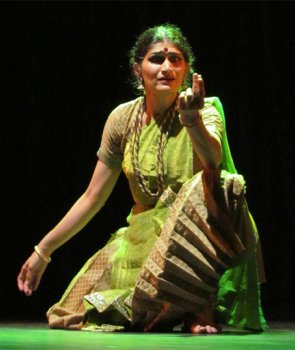
Chitra Chandrasekhar Dasarathy
It was a change to see a charming story depicted instead of the regular Bharatanatyam items. “I have been dancing themes and pieces other than the margam for some time now. So though this is not completely a new experience, I hope I am able to communicate an idea or story that I want to tell with this rich and expressive medium,” says Chitra. The beautiful music in Hindustani style was sung by Guru CV Chandrasekhar and MB Pallavi from Bangalore – an aural treat! “Apart from choice of ragas which we thought were most suitable I have also used the Thumri, Jhoola etc from the Hindustani music tradition of Banaras. These were traditionally women's musical forms which I have used in an extended context to become Saumanasa's song. Juxtaposing the alapana and tana sequences in the two voices is also to give a definite texture and personality to the characters. I did plan a lot over a long time and many things in my experiences in the arts have found place in the work both musically and choreographically.” Chitra was clad in an elegant beige and moss green costume. The braid decoration along her plait made out of simple coir and painted, and chains around her neck fashioned from twisted ropes made for some interesting aharya. The braid was to complement the colour and texture of her costume for woman/tree and also for keeping the suggestive quality in the costuming. In a pre-show chat, Ravi, secretary of Brahma Gana Sabha, said he feels enthusiasm for the season is markedly less this year, going by the ticket sales (he said in general for all sabhas) and the NRI crowd is also lesser. Tickets up to Rs.500 denomination were having decent sales, but not higher denomination, reflecting on the bad economy. Unlike earlier years, people were not willing to spend more. Programs presented by Brahma Gana Sabha have received mixed welcome, crowds turning up for programs when least expected and not turning up when expected! Next, it was sabha hopping to Bharatiya Vidya Bhavan to see an elegant Bharatanatyam recital by Janaki Rangarajan presented by Kartik Fine Arts. She performed a Lalgudi Jayaraman varnam “Innum en manam” in charukesi, two padams “Unnai thoodhu anuppinen” by Ghanam Krishna Iyer and “Thottu thottu pesa varaan” by Periasamy Thooran, finishing with a thillana in Purvi. She was accompanied by a distinguished orchestra – Hari Prasad on vocal, Jayashree Ramanathan on nattuvangam, Haribabu on mridangam and S Vijayaraghavan on violin. Interestingly, Janaki never repeats items during her season performances, so each time you watch her perform, it will be a different set of items. The dance connoisseurs present were sighing in admiration at her clear lines and charming abhinaya and proclaimed that after Malavika and Priyadarsini, Janaki is THE ONE.  Janaki Rangarajan 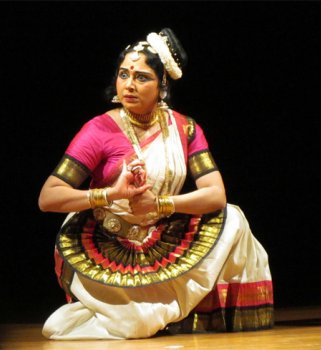 Gopika Varma The Music Academy dance fest got off to a start on Jan 3, with the first Natya Kala Acharya award for dance going to Padma Subrahmanyam. On accepting the award, Padma said music is the soul of dance and her singer Shyamala Balakrishnan used to be the soul of her programs till she passed on. “Getting this award is a happy coincidence since this year is Vazhuvoor’s centenary, my mother’s birth centenary, 60 years of my dance career and 70 years of Nrityodaya started by my father. The one lakh cash prize given by the Music Academy will go towards making of the statue of Bharatamuni for Bharata-Ilango Foundation for Asian Culture,” said Padma. Priyadarsini Govind gave the inaugural recital which was keenly commented upon by my neighbours in my row. “She seems light as a feather in the wind.” “She has long arms that I think are very suitable for dance.” “What bhaavam!” “Ooh, I hope she does not step on that earring. It will hurt her foot.” And so it went on. During the break for the next program, “Who is next?” “It is Gopika Varma. I think it is Odissi.” Once Gopika appeared on stage, enlightenment dawned, “Oh, it is Mohiniattam.” Now the recognition of various color changes in the fan of the costumes for the pancha kanyas were commented upon as well as guessing which color would be next. That was dual entertainment for me that evening. In ‘Sita Swayamvaram’ by Kalakshetra the next evening, one could notice the virtue of no movement as well as non-stop movement. The 2 female dancers who fan the seated king were at it rhythmically almost through the entire show. Didn’t their arms ache at all? The 4 performers on the left side of the stage including Sheejith Krishna as Ravana dressed in Kathakali costume, and the 3 on the right (Viswamitra, Rama and Lakshmana) sat frozen motionless for more than 20 minutes at a stretch while the dance was happening centre stage. Not even the slightest body twitch except for blinking now and then… That was amazing body control! The evening of Alarmel Valli’s program at the Academy was also entertaining. It is curious to see how total strangers ask such personal questions and get away with it! There was still 15 minutes to go for the show to start. Maami 2 asked maami 1 if the seat next to her was vacant and then occupied it. No sooner than it was question time as maami 1 fired one question after another at maami 2. “Where are you from?” “From US.” “Nowadays most people come from US for programs. Are you a dancer?” “Yes.” “Who is your guru?” “Pathagudi Ramaswamy and Swamimalai Rajaratnam Pillai.” “What is your name?” “Nirmala …” “Are you staying in a hotel?” “No, I’m staying with relatives.” “Did you buy ticket for the show?” “Yes, I got a season ticket.” Maami 2 was not to be outdone, so it was her turn next to fire questions at maami 1. “Are you a member of the Academy? Where do you live? How often do you come to US?” and so on went the exchange of pleasantries and during the intermission between Valli and Mahagami Gurukul’s Kathak program, they were chatting like old pals! The next morning at the Academy featured solos by Navia Natarajan and A Lakshman. As we were watching Navia perform, a gentleman introduced himself as a doctor and quietly distributed free copies of a book titled ‘Neighborhood Music and Health Guide’ to some audience members. More interesting was the announcement at the end of Lakshman’s recital, when the announcer said, “On behalf of Nrityalakshana, I request all of Lakshman’s students to kindly get up and give him a standing ovation” and one saw a scattering of his students stand up in bewilderment. Standing ovation on demand! Even more interesting was the discussion of ‘NRI dancers’ in the foyer about one dancer being unable to afford the high rates for live orchestra, another dancer scouting for orchestra for an upcoming program in Delhi...we helpfully suggested using recorded music! With so many things happening, snacks and tea time at the canteen is full of exchange of views. That evening before Rama Vaidyanathan’s performance, in a general chat over tea, scholar Manna Srinivasan said he found it ridiculous that some dancers make claims of having ‘discovered’ or ‘innovated’ something and try to put down the achievements of other artistes. “Nothing is new. You don’t make claims and speak about it. Let your art speak for you.” He and others at the table felt that after the season, maybe there should be a new ‘RAMP’ list. That coinage by Anita Ratnam seems to have become famous! Having tasted the sweet delicacy of the day every evening at the canteen, I wondered how sales have been this season. To my amazement, the guys at the bill counter said sales had been so fantastic during the music season that on one particular day, they had to open 2 counters and the returns touched nearly 3 lakhs! But the dance season saw crowds thinning and the previous day had grossed a mere Rs.13,000 only. Yummm… food for thought. Rama Vaidyanathan’s fabulous performance was followed by Yathagamanam by Ratikant Mohapatra and the well trained artistes of Srjan. ‘Jatayu Moksha’ choreographed by Ratikant and ‘Vande Mataram’ choreographed by Kelucharan Mohapatra were highly appreciated but the stunner of the evening was a song ‘Allah’ by Aruna Sairam to words of Subramania Bharati and choreographed by Ratikant Mohapatra. He had first heard this number sung by Aruna Sairam at NCPA in 2002 and she later sang it at the Guru Kelucharan Mohapatra fest in Bhubaneswar in 2004. That live recording was used for the program. Ratibabu came to Chennai to ask Aruna Sairam permission to use the recording and also learn the meaning of the lyrics. He actually wanted his father to choreograph the piece but Kelubabu passed away before that.
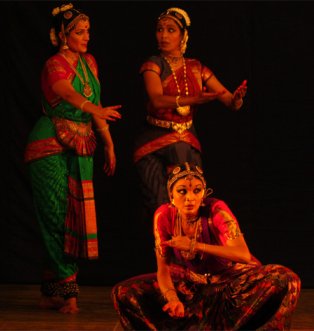 Vidhya Subramanian, Ramya Ramnarayan, Priyadarsini Govind 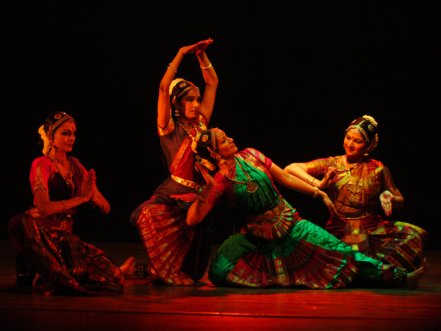 Priyadarsini Govind, Ramya Ramnarayan, Vidhya Subramanian, Srinidhi Chidambaram Taking a break from the Music Academy fest, I attended the second evening of the tribute function to Swamimalai K Rajaratnam Pillai at Narada Gana Sabha, organized by his daughter Jayakamala Pandian and the maestro’s disciples. Tributes were paid by The Dhananjayans, Rhadha, Adyar Lakshman and writer Tirupur Krishnan. To sum up, ‘Vadyar’ was a self made man who choreographed items to fit each individual’s talents, he treated his family members and students alike, he was large hearted, and a generally happy person with much camaraderie spirit. He was a great singer and whenever he sang, it was mesmerising. Vadyar’s style was greatly influenced by nadaswaram and that inspired him to choreograph many a mallari. His jathis and nattuvangam were outstanding. Though he choreographed many innovative new items, he never crossed the limits of tradition. The disciples he had trained so assiduously are carrying on his work around the globe as are his family members. An informative booklet on Rajaratnam Pillai released by Guru Dhananjayan and accepted by Rhadha was distributed free. With the speeches taking more than 90 minutes, the dance program finally commenced past 7pm. 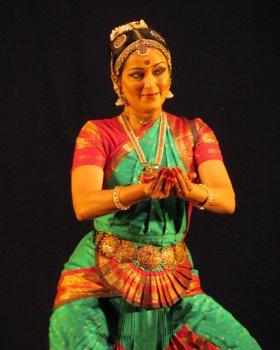 Vidhya Subramanian 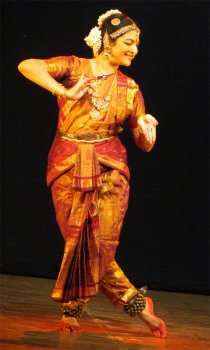 Srinidhi Chidambaram 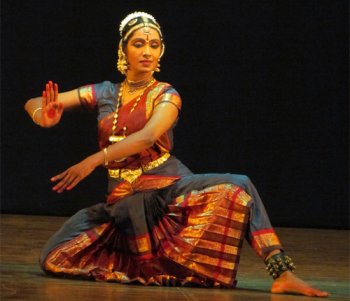 Ramya Ramnarayan 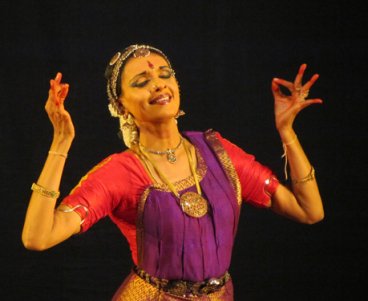 Priyadarsini Govind The program featured Pushpanjali in ragam Nattai, Jathi Layasaram, Natesa Kavuthuvam, a mallari composed by Muthuswami Pillai, an Annamayya composition on Dasavataram choreographed in 1985 where each story is narrated with sollu kattu, an item on Shiva’s dance as embodiment of all 9 rasas, an Annamayya composition on Alamelumanga and a thillana by Lalgudi Jayaraman. Anchored by Ramya Harishankar and Jothi Raghavan, the beautiful items choreographed by Vadyar were presented in stellar performances by his ace disciples Vidhya Subramanian, Priyadarsini Govind, Srinidhi Chidambaram, Ramya Ramnarayan, Nirupama Vaidyanathan and Sandhya Sree Atmakuri. They were ably supported by an orchestra led by the maestro’s nephew Swamimalai K Suresh. Being an evening when too many good performances were happening around the city, one can only say that those who did not attend really missed seeing the coming together of Vadyar’s prominent disciples on this special occasion. The dance program was interrupted for a few minutes by the late arrival of a chief guest but the speech happened nevertheless. It happens only in India! The last day of the Music Academy dance fest saw dancers looking tired after a hectic season of performing as well as attending shows. Narthaki Nataraj is happy that she has worked on research based projects this season, like ‘Sutta Pazham’ for Mad and Divine conference, and Navasandhi Kavuthuvam for Natya Kala Conference. She has prepared 4 sets of margams for the season since many dance aficionados attend more than one performance of hers. She is also performing items she has not done for 15 years, comparing the choreography of her Guru Kittappa Pillai to the fine embellishments on a piece of jewelry. Music Academy has been one of the best venues for performances. After the first three days of the dance fest, we found that the gaps between the side screens through which we could see artistes/personnel moving, were effectively closed with a dark screen, making the stage near perfect. Light director Victor Paulraj who did the lights for Rama Vaidyanathan said it was a pleasure to work at the Academy since they had freedom as well as ample lights needed for a dance recital and only in a rare instance, they needed few extra lights for particular special effects. Audience etiquette has also improved with those wanting to leave in the middle of a show, doing so only between items. But the trend of clapping after every set of jathis continues in all sabhas! Lalitha Venkat is the content editor of narthaki.com |